Disks are 2x Western Digital Red 4TB. All configurations are RAID 1. (Technically Storage Spaces Mirror isn't true RAID 1, but it's the closest possible for this comparison.)
Disregard the varying partition sizes - all tests are at the start of the drives.
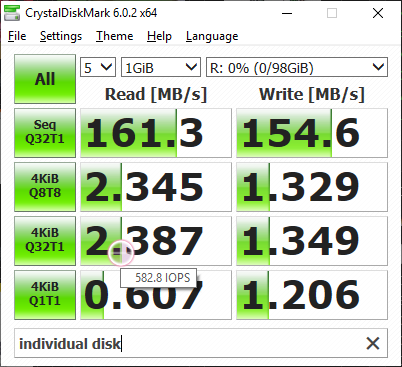
Dynamic Disk
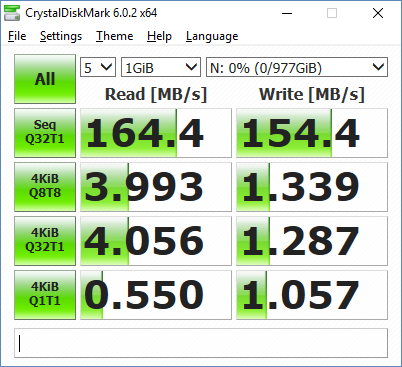
Seems to be good for performance, and is more portable than any hardware or fake RAID. Contrary to some outdated posts elsewhere, it does distribute reads across both drives. However it does not distribute sequential reads, so performance is not as great as it could be for some workloads.
The major drawback is how easily resync is triggered and how much it destroys performance for real-world read loads until complete. For example I loaded Divinity 2 while resyncing and it took minutes as opposed to seconds. Any time you happen to BSOD or otherwise improperly shutdown, or even hibernate (including fast startup) it triggers a resync.
Partition management is limited - the only software I could find capable of editing an existing Dynamic Disk setup was EaseUS, and when tested it froze attempting to resize an empty partition and hosed the RAID. Additionally if you have more than one partition on a dynamic disk RAID, resyncing occurs on each partition simultaneously, so on standard hard disks it destroys resync performance to have more than one partition!
Overall good performance and well-supported for future migrations, but a no-go for more than one partition, large disks, hibernation or PCs without flawless stability.
Storage Spaces
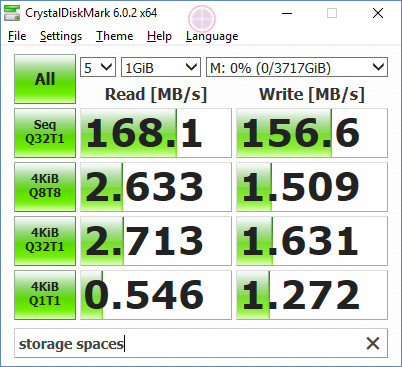
For the longest time I've been using Storage Spaces with zero data issues, but the poor performance of gaming workloads pushed me to look for alternatives. The preallocation done by Steam and Fortnite updates is extremely slow under Storage Spaces compared to bare disks(!) or any other type of RAID I've tried.
The benchmark results mask just how slow certain workloads can be - anything that involves reading/writing to the same file (e.g. patching) or allocating a large file using a non Windows API approach is dog slow. (OTOH fsutil file createnew is fast.)
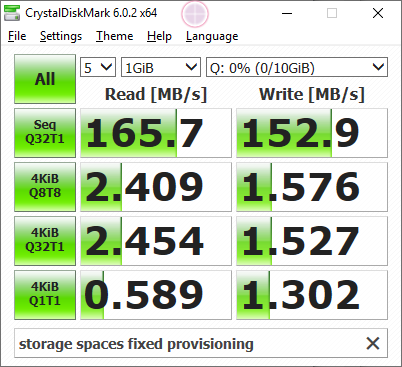
That said, Storage Spaces still manages to outperform a single disk slightly for reads, and even for writes, with the latter likely due to the abstraction reordering the random writes produced by CrystalDiskMark into something more optimal.
I've seen little discussion of Fixed provisioning of Storage Spaces online - it's hidden behind arcane powershell commands. As it supports normal defrag (which implies a more natural on disk format) I was hoping for performance to exceed thin provisioned storage spaces, but it is actually slower across the board. There doesn't seem to be any reason to use fixed provisioning over the default thin provisioned mode.
Speaking of on disk formats, it scares me slightly that the contents of each disk isn't a carbon copy of the other.
Compared to dynamic disks, partition management is good - you can resize and add/remove partitions at will with even more flexibility than an ordinary disk. Tools support is good as each partition is presented to the system as a Basic disk.
The resyncing issue of Dynamic Disks doesn't exist at all in Storage Spaces - throughout countless BSODs, resets, power losses, etc. I've not once seen Storage Spaces do any kind of resyncing, nor have I experienced any issues with my data stored on it.
Overall good support and a solid choice if redundancy and data protection are your aims, but the performance is lacking
Intel Rapid Storage Technology
I never thought I'd find myself considering fake RAID, but given I'm currently using a Supermicro server motherboard in my desktop with a special 'enterprise' incarnation of Intel RST, I figured I'd give it a shot. Note: I have reason to believe the performance of RSTe (as opposed to RST on desktop-grade motherboards) is improved, especially for RAID 1, so take these numbers with a pinch of salt.
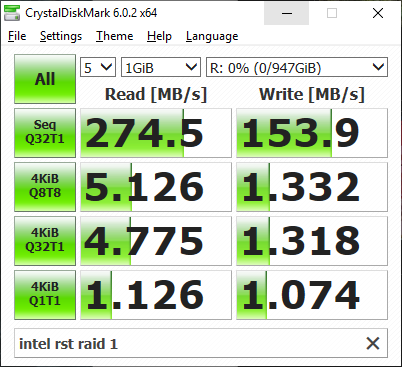
The benchmark results for read performance eclipse the other options - even sequential reads are distributed across both disks. Writes are slower, but this is with all the dangerous write caching options disabled (I have no UPS). I can confirm these performance figures in real world performance - everything is subjectively faster than the other configurations.
I'm mildly concerned about what happens when I upgrade my PC and/or my motherboard fails, as my future plans lie with AMD. I put my mind at ease slightly when I discovered there is an option (unique to RAID 1) on RST that can turn the first disk back into a standard non-RAID disk without rewriting the data, so the on disk format must be close to an individual disk. Seeing the amount of recovery software available as well as a pure-software implementation in Linux also gives me hope I'm not digging my data into a hole. I actually feel happier with Intel RST than I would do with a hardware RAID card in this regard - at least it will work on any Intel board rather than one particular RAID controller.
This is good old fashioned fake raid, so partition management and tools support is flawless - as far as software is concerned it is a single disk.
Like Dynamic Disks, resyncing is an issue in the case of unclean shutdowns/BSODs/etc, but from my experience it only occurs in rare cases - many unclean shutdowns do not trigger it. It is also a nicer implementation - not triggered by hibernation/sleep, and it can be paused and resumed by hibernation or shutdown, as opposed to dynamic disks which will restart from scratch. It also does not attempt to resync multiple partitions at once, so it is a relatively fast linear operation. System performance impact during resyncing is roughly the same as dynamic disks - i.e. significant.
Overall performance is excellent, software support is flawless, future thinking is slightly better than true hardware RAID but behind the other software options.
Final thoughts
There's no one-size-fits-all solution, but I've found myself doing a complete 180 from 'lol fake raid who uses that' to actually recommending Intel RST above other options for Windows.
Dynamic Disks work well until you inadvertently trigger a resync, then you spend the next day being reminded of how bad they are. The design goals behind Storage Spaces - archival and flexibility - clearly come at the cost of performance.
I've ignored proper RAID cards, but ultimately until Microsoft get their act together and create something on the same level of MD or BTRFS, hardware remains king. I wouldn't be surprised if there was indeed a financial reason why software RAID is slower on Windows.
3 months later...

An update on this: I've decided to move my RAID storage to BTRFS RAID 1 and access it on Windows via SMB. Performance is remarkably good - the better Linux IO scheduler and impressive Windows smb caching cancel out most of the overhead of smb/network. Real world use is at least as good as Storage Spaces. Benchmark results are (misleadingly) far better than the other solutions.
Annoyingly some software (Epic Games launcher, Battle.net, etc) refuses to work on a network share, but Steam works well. The integrity checking of data on BTRFS trumps all these issues in my book, alongside regular backups in case BTRFS itself falls over. Plus with zstd compression and subvolumes (shared free space), I was able to condense 6TB worth of disks into 4TB.
During the process of moving, I discovered I could mount one of the Intel RAID 1 disks on Linux directly as if it were a standalone disk (with no additional configuration) - so this is a huge positive for the safety of data on Intel RAID 1 in case of motherboard failure.
Comments
How do you get the Intel RST RAID1 drive to be recognized with Windows? I am trying to use two drives in RAID1 as a data drive with Windows. I created the RAID1 drive with Intel RST and then use Storage Spaces to create a simple (no resiliency) space. I am guessing that the underlying RAID 1 drive is duplicating the data between the two hard drives?
For anyone that comes across this.. I’ve used Intel RST RAID 1 for the past 15+ years under Windows. I’ve gone through at least 3 server rebuilds to new hardware with no issues. There is no tie between RST and data, so the disks are always usable when pulled right out of the server. RST has always been rock solid with very few resyncs. I don’t use my mirrored drives as work drives; I just store data on them, so I’ve kept write cache buffer flushing enabled. I am about to build another iteration and have been researching other options, but it appears that RST is still the best Windows option out there from what I’ve come across. Good luck!
would be interesting to see raid0 comparisons. as for games you just need speed. not redundancy
Nice post on this subject. How are you attaching the storage on your Windows client? In my experience using subst makes most software unaware whats underneath it and you might be able to get some of those launchers running.
Years ago I used intel motherboard raid 1 with a manual resync. With the manual resync it was more like having a clone of my main drive. I found it to be solid and used it for several years with no issues. I could boot with either disk and recovery was easy. I used it for years until I started using WHS 2010 for data protection which brings me to present day where i am now looking to get rid of WHS 2010. I tried a windows Storage Space RAID 1 on my windows 10 machine and found it to be unstable and recovery was not simple. I had 1 drive drop and become unsynched. Problem was entirely a software problem and not a drive problem. So I don’t trust Storage Spaces at all and am looking at going back to the intel RST firmware based RAID which it looks like you also have a positive impression of. Thanks for taking the time of documenting your experience and even supplying data. You did a really nice job.
Any chance of putting all the benchmarks side-by-side or, at least, a little closer? Hard to compare while scrolling up and down…
hmmm is this targeting feminists? i am sjw
this is a good post